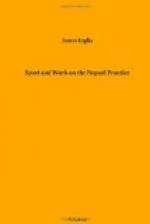The beating now is mostly done by machinery; but the old style was very different. A gang of coolies (generally Dangurs) were put into the vats, having long sticks with a disc at the end, with which, standing in two rows, they threw up the liquor into the air. The quantity forced up by the one coolie encounters in mid air that sent up by the man standing immediately opposite to him, and the two jets meeting and mixing confusedly together, tumble down in broken frothy masses into the vat. Beginning with a slow steady stroke the coolies gradually increase the pace, shouting out a hoarse wild song at intervals; till, what with the swish and splash of the falling water, the measured beat of the furrovahs or beating rods, and the yells and cries with which they excite each other, the noise is almost deafening. The water, which at first is of a yellowish green, is now beginning to assume an intense blue tint; this is the result of the oxygenation going on. As the blue deepens, the exertions of the coolie increase, till with every muscle straining, head thrown back, chest expanded, his long black hair dripping with white foam, and his bronzed naked body glistening with blue liquor, he yells and shouts and twists and contorts his body till he looks like a true ‘blue devil.’ To see eight or ten vats full of yelling howling blue creatures, the water splashing high in mid air, the foam flecking the walls, and the measured beat of the furrovahs rising weird-like into the morning air, is almost enough to shake the nerve of a stranger, but it is music in the planter’s ear, and he can scarce refrain from yelling out in sympathy with his coolies, and sharing in their frantic excitement. Indeed it is often necessary to encourage them if a vat proves obstinate, and the colour refuses to come—an event which occasionally does happen. It is very hard work beating, and when this constant violent exercise is kept up for about three hours (which is the time generally taken), the coolies are pretty well exhausted, and require a rest.
[Illustration: INDIGO BEATERS AT WORK IN THE VATS.]
During the beating, two processes are going on simultaneously. One is chemical—oxygenation—turning the yellowish green dye into a deep intense blue: the other is mechanical—a separation of the particles of dye from the water in which it is held in solution. The beating seems to do this, causing the dye to granulate in larger particles.
When the vat has been beaten, the coolies remove the froth and scum from the surface of the water, and then leave the contents to settle. The fecula or dye, or mall, as it is technically called, now settles at the bottom of the vat in a soft pulpy sediment, and the waste liquor left on the top is let off through graduated holes in the front. Pin after pin is gradually removed, and the clear sherry-coloured waste allowed to run out till the last hole in the series is reached, and nothing but




